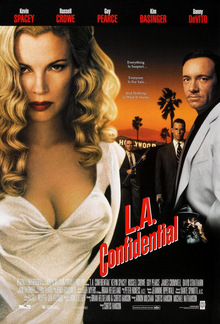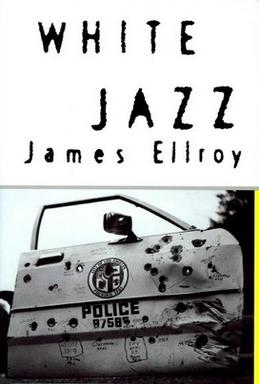Critical response
On review aggregator website Rotten Tomatoes, L.A. Confidential holds an approval rating of 99% and an average rating of 9/10, with 162 out of 163 reviews being positive. The site's critical consensus reads: "Taut pacing, brilliantly dense writing and Oscar-worthy acting combine to produce a smart, popcorn-friendly thrill ride." [3] The film later appeared on top of the site's list of the "300 Best Movies of All Time", a synthesis of critic and user reviews. [27] On Metacritic the film has a weighted average score of 90 out of 100, based on 28 critics, indicating "universal acclaim". [4] Audiences polled by CinemaScore gave the film an average grade of "A−" on an A+ to F scale. [28]
Film critic Roger Ebert gave the film four out of four stars and described it as "seductive and beautiful, cynical and twisted, and one of the best films of the year." [29] He later included it as one of his "Great Movies" and described it as "film noir, and so it is, but it is more: Unusually for a crime film, it deals with the psychology of the characters ... It contains all the elements of police action, but in a sharply clipped, more economical style; the action exists not for itself but to provide an arena for the personalities". [30]
In her review for The New York Times , Janet Maslin wrote, "Mr. Spacey is at his insinuating best, languid and debonair, in a much more offbeat performance than this film could have drawn from a more conventional star. And the two Australian actors, tightly wound Mr. Pearce and fiery, brawny Mr. Crowe, qualify as revelations." [31] Desson Howe's review for The Washington Post praised the cast: "Pearce makes a wonderful prude who gets progressively tougher and more jaded. New Zealand-born Crowe has a unique and sexy toughness; imagine Mickey Rourke without the attitude. Although she's playing a stock character, Basinger exudes a sort of chaste sultriness. Spacey is always enjoyable." [32]
In his review for The Globe and Mail , Liam Lacey wrote, "The big star is Los Angeles itself. Like Roman Polanski's depiction of Los Angeles in the '30s in Chinatown , the atmosphere and detailed production design are a rich gel where the strands of narrative form." [33] USA Today gave the film three and a half stars out of four, writing, "It appears as if screenwriters Brian Helgeland and Curtis Hanson have pulled off a miracle in keeping multiple stories straight. Have they ever. Ellroy's novel has four extra layers of plot and three times as many characters ... the writers have trimmed unwieldy muscle, not just fat, and gotten away with it." [34]
In his review for Newsweek , David Ansen wrote, "L.A. Confidential asks the audience to raise its level a bit, too—you actually have to pay attention to follow the double-crossing intricacies of the plot. The reward for your work is dark and dirty fun." [35] Richard Schickel, in his review for Time , wrote, "It's a movie of shadows and half lights, the best approximation of the old black-and-white noir look anyone has yet managed on color stock. But it's no idle exercise in style. The film's look suggests how deep the tradition of police corruption runs." [36] Writing in Time Out New York , Andrew Johnston observed: "Large chunks of Ellroy's brilliant (and often hilarious) dialogue are preserved, and the actors clearly relish the meaty lines. Dante Spinotti's lush cinematography and Jeanne Oppewall's crisp, meticulous production design produce an eye-popping tableau of '50s glamour and sleaze." [37]
In his review for The New York Observer , Andrew Sarris wrote, "Mr. Crowe strikes the deepest registers with the tortured character of Bud White, a part that has had less cut out of it from the book than either Mr. Spacey's or Mr. Pearce's ... but Mr. Crowe at moments reminded me of James Cagney's poignant performance in Charles Vidor's Love Me or Leave Me (1955), and I can think of no higher praise." [38] Kenneth Turan, in his review for Los Angeles Times , wrote, "The only potential audience drawback L.A. Confidential has is its reliance on unsettling bursts of violence, both bloody shootings and intense physical beatings that give the picture a palpable air of menace. Overriding that, finally, is the film's complete command of its material." [39] In his review for The Independent , Ryan Gilbey wrote, "In fact, it's a very well made and intelligent picture, assembled with an attention to detail, both in plot and characterisation, that you might have feared was all but extinct in mainstream American cinema." [40] [41] Richard Williams, in his review for The Guardian , wrote, "L.A. Confidential gets just about everything right. The light, the architecture, the slang, the music ... a wonderful Lana Turner joke. A sense, above all, of damaged people arriving to make new lives and getting seduced by the scent of night-blooming jasmine, the perfume of corruption." [42]
Some authors have described L.A. Confidential as a neo-noir film. [43] [44]











